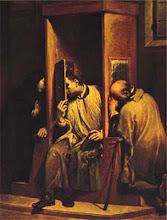BLESSED JANE, popularly called Vanna, belonged to July 23 the peasant class, and was born at Carnajola, near Orvieto, in Italy, A.D. 1264. She was left an orphan at the age of five, and some of her playfellows told her that, now she had neither father nor mother, there was no one to care for her. Little Jane immediately led them to the church, and pointing to a picture of the Guardian Angel, said, " Behold him who will hold the place of father and mother to me. I have a better parent than you." Divine Providence came to the assistance of the little orphan, and she was adopted by some members of her family who lived at Orvieto. These people were anxious that she should enter the married state as soon as her age would permit, but Jane's heart had been consecrated from childhood to a Heavenly Spouse. To escape their importunity she fled to the house of a friend who lived in the country, and entered the Third Order of Saint Dominic.(Short Lives of Dominican Saints, 205-208 (1901)).
In the school of the Divine Master she was taught the virtues of the religious life, detachment from earthly things, patience, obedience, humility, a tender charity for the poor and the sick ; above all, an ardent love of God. So brightly did this heavenly flame burn within her, that, during her long devotions, which occupied great part of the day, she could bear only the lightest clothing, and the bare mention of the love of Jesus, of the maternal goodness of Mary, or of the sufferings of a martyr, sufficed to throw her into an ecstasy. Every Good Friday but one, during the last nine years of her life, she was favoured with an extraordinary rapture, lasting from mid-day until evening, during which her body lay stiff and motionless in the attitude of the crucifix, and her bones were distinctly heard to crack, as though being violently dislocated.
One Christmas night, as she was grieving that sickness prevented her from assisting at Midnight Mass and receiving the Divine Infant in Holy Communion, her little chamber was miraculously flooded with light, in the midst of which appeared a white Host, which descended into her breast. On another occasion, when she was again confined to her bed by illness, our Blessed Lady appeared to her, bearing the Divine Infant in her arms. " Jane," said the Holy Child, " thou canst not to-day receive Me in Holy Communion, but I am ever thine by grace."
Blessed Jane strove to conceal from the knowledge of all the Divine favours which were lavished upon her; she sincerely regarded herself as the worst of sinners, and nothing caused her so much pain as to see herself treated with respect and veneration. On the other hand, she looked upon those who ill-treated her as her benefactors. One day, when a woman had grossly insulted her, she said, " I am sorry that I am so weak as to be unable to do a severe penance for this poor woman's sins; at any rate, I shall have the pleasure of saying two hundred Paters and Aves for her." Hence it passed into a proverb at Orvieto, that, in order to obtain an abundant share in Sister Jane's prayers, one must do her some injury.
She was endowed with the gift of prophecy, and amongst other things predicted some of the miracles which she was to work after her death. She had to endure cruel persecution from the devils, who were sometimes suffered to beat and otherwise ill-treat her; but she bore all with the utmost courage and patience.
Towards the close of her life, Blessed Jane had the happiness of having for her spiritual director Blessed James of Bevagna, who was at that time exercising the office of Lector and Preacher in the Convent at Orvieto. At the beginning of the August of 1301, this holy man had occasion to visit the Convent he had founded at Bevagna, and there he was attacked by his last illness and happily departed to our Lord. On the morning of his death, Blessed Jane, who did not even know that he was ill, was praying in the Church of the Friars at Orvieto, when she saw her holy confessor coming towards her. She was greatly rejoiced at the sight, and begged him to hear her confession, which he accordingly did. He then gave her his belt and his knife, to keep in remembrance of him. In the course of the afternoon, Blessed Jane sent a small present to the Convent by a servant, who brought back word that Father James was dying at Bevagna. " Impossible !" said the servant of God, " I saw him in church this morning; " and she produced the things which he had given her and which the Fathers perfectly recognised as having been those used by her saintly director. They then despatched messengers to Bevagna, who found that Blessed James had indeed died that morning, and that his body was lying exposed in the church.
Blessed Jane prepared for her own last passage with the greatest fervour, and, fortified by the holy Sacraments of the Church, departed to her Spouse on the 23rd of July, A.D. 1306. Many visions and miracles bore witness to the glory which she had attained in heaven. Fifteen months after her death, when her body was removed to a more fitting resting-place, it was found perfectly flexible and incorrupt. She was beatified by Benedict XIV.
Prayer
O God,
who didst reward by an increase of heavenly gifts
the singular purity and fervent love of Blessed Jane, Thy Virgin,
grant that we may so imitate her virtues
as to be ever pleasing to Thee,
by the chastity of our lives
and the purity of all our affections.
Through Christ our Lord.
Amen.





















